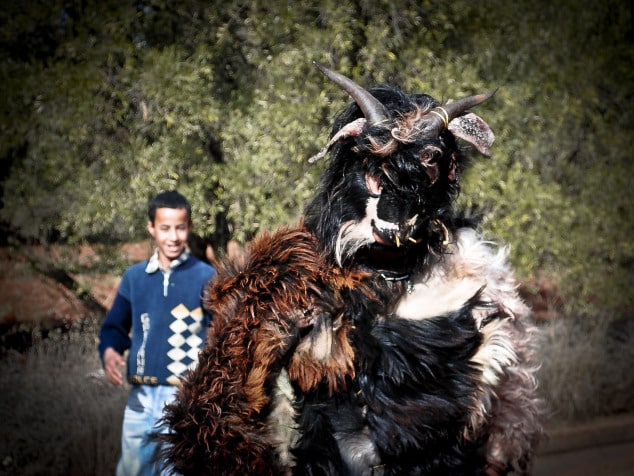« Bilmawn», « Bu-jelloud » or even « Hrrma » or « Bu-lbtayen » also known as the Amazigh Halloween, all names of the same tradition according to each region in Morocco. It’s a popular Amazigh masquerade tradition organized following the celebration of Eid El Kebir (tafaska in Amazigh language).
Accompanied by a dozen masked people, the « Bu-ilmawn » disguise themselves using goat skins and / or sheep and play theatrical scenes that spread joy and fun in the alleys of the city.
It involves individuals wearing the skins of rams or goats along with face paint with charcoal or wear masks and roaming the neighborhood streets, going from door to door asking for money or sheep and goat skins. with the help of popular bands to create joy and pleasure in the ranks of spectators, and at the same time creates Bilmawn panic and fear especially among children and women. Some say that to touch the skin being worn can bring good fortune. If it sounds familiar, then it is probably because it is an ancient echo of Halloween.

Researchers, say the custom is ancient tradition and has its origins in Africa, inspired by the legends of a leather-clad monster that terrorised people in remote areas. It may also have reflected a tribal raiding party dressed in skins.
Professor Bouyaakoubi of Anthropology explained at the University Ibn Zahr south-west of Morocco, that this cultural practice reflects Amazigh human quest to keep this tradition, which is shared by the peoples of North Africa and the Canary Islands with “under” different names.”
He added that the “Carnival has several names depending on the country, they speak Tamazight or Darija in various North African regions. Among the names of the carnival, we find (Bilmawn) (Boujeloud) (Harma) (los Carneros Tigaday) Canary Island (Tamaazat) Souss (south), and in the Middle Atlas (center), we find (Boyaslikhn, Boybatane), Anti Atlas “Isemgane, Imaachar “and Rif (north) Ba-Sheikh”.
He continued: “We also find the word-Darija (Bolbatayn) or (seven Batain) related to the number required to wear skins per person”
While Bilmawn or Boujloud is not celebrated in every area of Morocco it can be found in places such as Tiznit, Agadir and Amazigh regions in the south of the country and the Rif Mountains in the north. The festival is notable because of the participation of both males and females. In some area the festival has been turned into a local carnival lasting up to seven days and expanded to include concerts of folk music. This change has made Boujloud into a cultural event that highlights the Amazigh cultural heritage and attracts thousands of tourists who come specifically to see the “Carnival Boujloud “.

